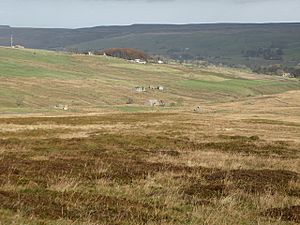Allendale Moors facts for kids
| Site of Special Scientific Interest | |

Allendale Common, moorland at the south-east of the SSSI
|
|
| Area of Search | Northumberland |
|---|---|
| Grid reference | , |
| Coordinates | 54°49′51″N 2°17′10″W / 54.8309°N 2.2861°W |
| Interest | Biological |
| Area | 5,282.81 hectares (20 sq mi) |
| Notification | 1998 |
| Location map | DEFRA MAGIC map |
Allendale Moors is a very special natural area in Northumberland, England. It is officially known as a Site of Special Scientific Interest (SSSI). This means it's protected because it has important wildlife and habitats. The area is a large stretch of high, open land called moorland. It's famous for its unique plants and as a home for many important moorland birds.
Contents
Where is Allendale Moors Located?
Allendale Moors is in the north-east of England. It's about 6 miles (10 km) east of Alston and half a mile (0.8 km) west of Allenheads. This area is found in the south-west part of Northumberland.
The site is shaped like a "U" and stretches about 7.4 miles (12 km) from north to south. It is also about 6 miles (10 km) wide from east to west. Allendale Moors is part of the North Pennines, a beautiful area known as an Area of Outstanding Natural Beauty. It also touches other special protected sites nearby.
The Landscape of the Moors
Allendale Moors is made up of high moorland ridges and flat areas called plateaus. The land rises from about 400 meters (1,300 feet) in the north to over 600 meters (2,000 feet) in the south.
This area has one of the biggest "blanket mires" in northern England. A blanket mire is a large, wet, peaty bog that covers the landscape like a blanket. These bogs create different types of habitats. They include heathland, wet areas called flushes, and grassy uplands. These are perfect homes for many moorland birds.
Underneath the boggy ground, there is Carboniferous limestone. This rock is very old and has lots of lichen growing on it. The Allendale area has a long history of mining for minerals like zinc and lead. Because of this, you can still see old piles of mining waste. Some special plants can grow here, even with the metals in the soil. One example is the spring sandwort.
What Plants Grow on Allendale Moors?
The moorland has different types of plant zones. Each zone has its own special plants.
Plants on the Plateau
The flat, high areas of the moorland are mostly covered by heather (Calluna vulgaris). You'll also find hare's-tail cottongrass (Eriophorum vaginatum) here. In some spots, there's cross-leaved heath (Erica tetralix). Other interesting plants include deergrass (Trichophorum cespitosum) and crowberry (Empetrum nigrum). You might also spot the round-leaved sundew (Drosera rotundifolia), which is a small carnivorous plant. Different types of bog mosses also grow here.
Dry Heath and Grasslands
Around the edges of the plateau, you'll find dry heath and acidic grasslands. The dry heath has heather, wavy hair-grass (Deschampsia flexuosa), and bilberry (Vaccinium myrtillus).
The grasslands are often dominated by heath rush (Juncus squarrosus). Other plants in these grassy areas include mat-grass (Nardus stricta), tormentil (Potentilla erecta), and heath bedstraw (Galium saxatile).
Wet Flushes and Lichens
The moor has many wet areas called "acidic flushes." These are often filled with soft-rush (Juncus effusus), bog moss (Sphagnum recurvum), and star-moss (Polytrichum commune).
Some flushes have even more types of plants. These include sharp-flowered rush (Juncus acutiflorus), common sedge (Carex nigra), and star sedge (Carex echinata). You might also see marsh bedstraw (Galium palustre), lesser spearwort (Ranunculus flammula), and marsh violet (Viola palustris).
The large limestone rocks, called Great Limestone outcrops, are home to many different lichens. Some of these lichens, like elm gyalecta (Gyalecta ulmi), are rare and important.
What Animals Live on Allendale Moors?
The open moorland is a very important place for breeding birds. Many of these birds are considered nationally important.
You can find birds like the merlin, golden plover, red grouse, and black grouse here. Other birds include the short-eared owl and dunlin. The moorland and its grasslands also support birds like the curlew, snipe, lapwing, and redshank.
Who Owns Allendale Moors?
The land is owned by Allendale Estates. This company manages the land for the 4th Viscount Allendale. Most of the site is "common land." This means that local people have certain rights to use the land, for example, for grazing animals. It is known as "Allendale Common and land at Mohope Moor and Pinch Park."

